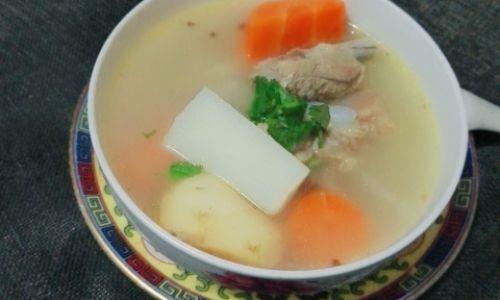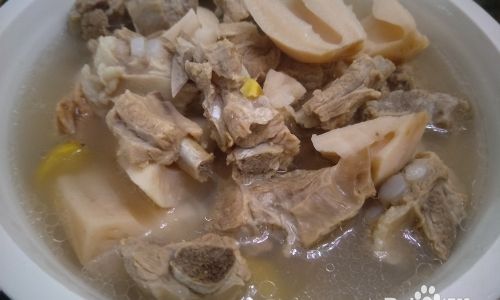Introduction
Rib soup, a dish cherished across various cultures for its rich flavor, tender meat, and nourishing broth, is a perfect choice for cold winter nights or anytime you crave comfort food. Whether you’re a seasoned chef or a novice in the kitchen, making rib soup can be both an enjoyable and rewarding experience. This comprehensive guide will walk you through the entire process, from selecting the best ribs to crafting a broth that will leave your taste buds singing. By the end, you’ll have a pot of aromatic, hearty rib soup that’s sure to become a family favorite.

Section 1: Choosing the Right Ribs
The foundation of any great rib soup is, of course, the ribs themselves. There are several types of ribs available, each with its unique texture and flavor profile. Here’s a breakdown of the most popular options:
-
Spare Ribs: These are larger and meatier, with a good balance of bone, fat, and meat. They’re often preferred for slow-cooking methods as they can handle longer cooking times without drying out.
-
Baby Back Ribs: Smaller and more tender, baby back ribs are closer to the backbone and have less fat and bone compared to spare ribs. They’re ideal for quicker cooking methods but can also be used in soups, albeit in smaller quantities due to their higher cost.
-
Short Ribs: These are typically cut from the beef chuck or plate primal, and they’re known for their rich, beefy flavor and marbled fat. Short ribs are perfect for slow-cooking as the fat melts into the meat and broth, creating an incredibly flavorful dish.
When selecting ribs for soup, look for meat that is well-marbled and has a fresh, slightly pink hue. Avoid ribs that appear overly dry, discolored, or have an unpleasant odor. Additionally, consider the size of your pot and the number of servings you plan to prepare to determine how many ribs you need.
Section 2: Preparing the Ribs

Before you dive into cooking, there are a few essential steps to prepare your ribs:
-
Trimming: Remove any excess fat, silver skin, or bones that might not contribute positively to the soup’s texture. This step is particularly important with spare ribs, which can have quite a bit of fat.
-
Seasoning: Season your ribs generously with salt and pepper. You can also add other spices like garlic powder, paprika, or a touch of chili powder if you prefer a bit of heat.
-
Searing: To lock in juices and add depth to the broth, sear the ribs in a hot pan with a bit of oil until they’re browned on all sides. This process also helps to develop a flavorful fond on the bottom of the pan, which can be deglazed and added to the soup for extra flavor.
Section 3: Selecting and Preparing the Broth Ingredients
The broth is the soul of rib soup, and its flavor can be enhanced through careful selection and preparation of ingredients. Here are some key components:
-
Vegetables: Carrots, celery, and onions are the classic mirepoix, providing a sweet and savory base. You can also add tomatoes, leeks, or garlic for additional layers of flavor.

-
Aromatics: Bay leaves, thyme, rosemary, and black peppercorns are essential for creating a fragrant and complex broth. Whole spices are preferable as they can be easily removed before serving.
-
Liquid: Chicken or beef broth offers a rich, savory foundation. You can use homemade broth for maximum flavor or a good-quality store-bought variety. For added depth, consider incorporating a splash of red wine or apple cider vinegar, which helps to extract more flavor from the bones and meat.
-
Herbs: Fresh parsley, cilantro, or dill can be added at the end for a burst of freshness.
Section 4: Cooking the Rib Soup
Now that you have all your ingredients prepared, it’s time to cook the soup. Here’s a step-by-step guide:
-
Sautéing Vegetables: In a large pot or Dutch oven, sauté the chopped vegetables (mirepoix) until they’re soft and translucent. This releases their natural sugars and creates a sweet, aromatic base.
-
Adding Aromatics: Stir in the whole spices and cook for another minute or two to toast them lightly and release their fragrances.

-
Deglazing: If you seared your ribs, pour the deglazing liquid (such as wine, broth, or vinegar) into the pan and scrape up the fond. Add this to your pot.
-
Adding Ribs and Broth: Place the seasoned and seared ribs into the pot, nestling them among the vegetables. Pour in enough broth to fully submerge the ribs. Bring the mixture to a boil, then reduce the heat to a simmer.
-
Simmering: Cover the pot and let the soup simmer gently. Cooking time will depend on the type of ribs and your preferred level of tenderness. Generally, spare ribs and short ribs can take several hours (3-4) to become tender, while baby back ribs may require less time (1.5-2 hours).
-
Tasting and Adjusting: Periodically check the soup, skimming off any foam that rises to the surface. Taste the broth and adjust the seasoning with salt and pepper as needed.
Section 5: Finishing Touches
Once the ribs are tender and the broth is flavorful, it’s time to finish your soup:
-
Removing Ribs: Carefully remove the ribs from the pot and let them cool slightly. You can either shred the meat and return it to the soup for a heartier texture or serve the ribs whole on the side.

-
Thickening (Optional): If you prefer a thicker broth, you can make a slurry with a bit of cornstarch and water, then stir it into the soup and let it simmer for a few minutes.
-
Adding Fresh Herbs: Stir in freshly chopped herbs like parsley or cilantro just before serving to preserve their bright flavors.
-
Serving: Ladle the soup into bowls, garnish with additional herbs, a squeeze of lemon juice, or a dollop of sour cream if desired, and enjoy.
Conclusion
Making rib soup may seem like a daunting task, but with the right ingredients and techniques, it can be a rewarding and delicious endeavor. By following this guide, you’ll be able to create a hearty, flavorful rib soup that’s sure to warm your body and soul. Whether you’re feeding a crowd or simply treating yourself, this dish promises to deliver comfort and satisfaction in every spoonful. Happy cooking!






0 comments